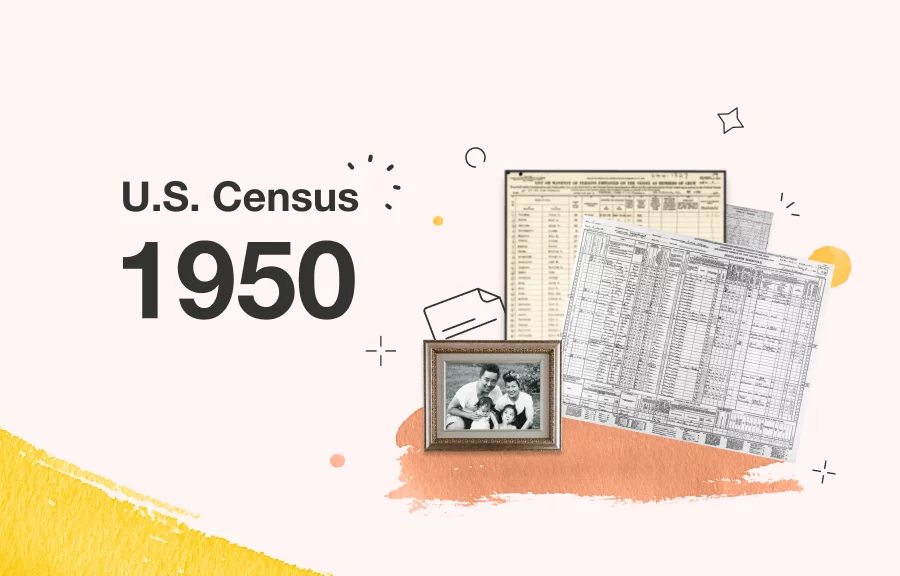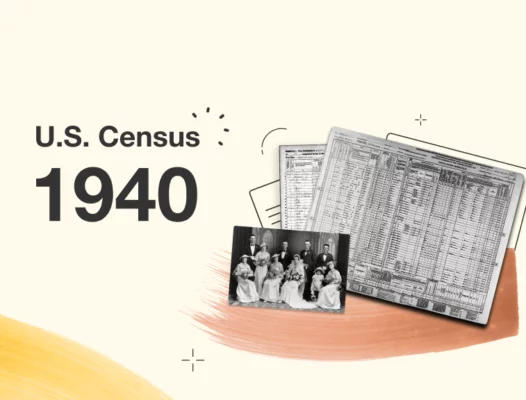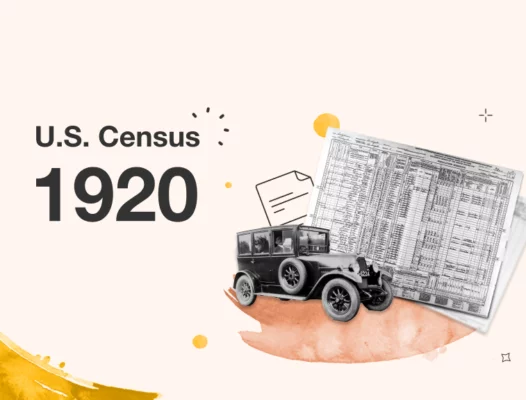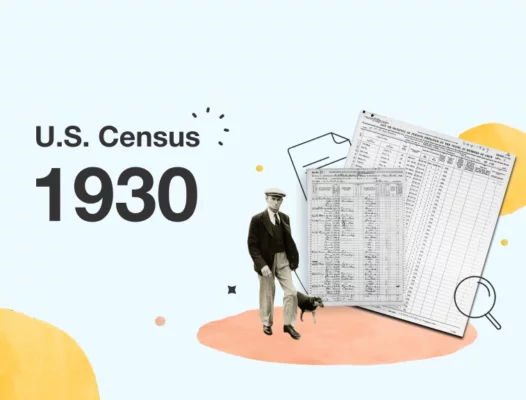The 1950 U.S. Census: Discover Your Family History from 1950

The 1950 U.S. Census can provide an intriguing window into the lives of your ancestors during the very middle of the 20th century. Taken in April of 1950, this census provides rich details on the lives of the 150 million Americans living in the United States and its territories during this fascinating period.
Who knows what you might discover about your own ancestors in the 1950 U.S. Census?
Search the 1950 Census for Free on MyHeritage!
The 1950 U.S. Federal Census was officially available to the public starting on April 1, 2022 — exactly 72 years after the enumeration began. MyHeritage was the first commercial company to offer all of the 1950 census images as a collection. Soon after, MyHeritage began publishing the fully searchable 1950 United States Census Index collection, which includes the indexed records and their accompanying images, in regular installments. As of April 20, the fully indexed states and territories available to search on MyHeritage include Wyoming, Delaware, Vermont, Alaska, New Hampshire, Rhode Island, South Dakota, and a number of additional regions. The index is growing every few days and will be continuously updated until it encompasses the entire 1950 Census. All of the records are available to search, view, and add to your family tree on MyHeritage for free!
Search the US 1950 Census Records by State
Read more about the 1950 Census release in our blog post, The 1950 U.S. Census is coming to MyHeritage! Free!
Searching the 1950 Census on MyHeritage
Though census records are available to the public on the National Archives website, searching on MyHeritage offers invaluable additional benefits:
- Advanced search capabilities: Using MyHeritage’s search engine, you can search for your ancestors according to any criteria and not just name, home address, or enumeration district. MyHeritage’s sophisticated search algorithms can even identify nicknames and name variations from other languages.
- Easily flip between records within the family: MyHeritage allows you to easily flip between census records of individuals in the same family group. Family members are listed on the record page, and you can click their names to go to their records.
- Explore related records: When you are viewing records on MyHeritage, you’ll see additional historical records that mention the person you are researching. Our database includes more than 16 billion records and is constantly growing.
- Receive automatic Record Matches: When you build a family tree on MyHeritage, you won’t even need to search actively. MyHeritage finds historical records that mention the people in your family tree and delivers them straight to your inbox.
- Extract new information straight to your family tree: Extracting information from historical records and placing it on your online family tree is as simple as a few clicks on MyHeritage.
Get more tips by watching Preparing for the 1950 Census: How-to Search the U.S. Census Records:
What can the 1950s Census show us about our ancestors?
The 1950 Census will reveal important details about our ancestors’ lives, for example:
- Their place of residence
- The people they were living with
- Their occupations
- Their ages
- Their birthplaces
- Their immigration statuses
Reviewing these details can help you discover new details about your ancestors, or confirm what you already know.
The 1950 Census covered a larger geographic area than any census that came before, and it was also the first to include Americans living abroad. This means you just might come across some ancestors who didn’t show up in previous censuses.
We’ll elaborate on the exact information collected on the census below.
What changed from the 1940 Census to the 1950 Census?
The decade that passed between 1940 and 1950 was one of the most eventful in human history. World War II had only just started when the 1940 Census was completed. The war ended in 1945, and by 1950, the post-war baby boom was well underway. Scientific and technological discoveries were moving forward at lightning speed, from the hereditary properties of DNA to the first successful digital computer.
The population of the United States grew 14.5% from 132,164,569 to 151,325,798 — almost double the growth rate from the previous decade. This population boom made the task of enumeration particularly daunting. The 1950 Census was the last U.S. census to be done in person — by 1960, the census was taken by mail-in questionnaires. It was no small feat to send out enumerators to knock on every door in the United States with more than 150 million residents!
Accordingly, some changes were made to ensure that the outcome was as accurate and complete as possible. These measures included:
- Better training and organization for enumerators
- Detailed maps of enumeration districts
- Special infant cards for babies born between January and March 1950, since young infants were easily missed
- A planned special enumeration of “transients” took place on April 11 for hotels, tourist courts, etc.
- “Missed Person” forms were published in newspapers so people who thought they were missed could fill out a form and mail it to the district supervisors
- A post-enumeration survey
How were people counted in the 1950 Census?
The primary goal of the census is to understand how many people were living in the United States at the time. Therefore, the methodology of enumeration was based around the place of residence. Enumerators were each assigned a specific district where they were to go door to door, ask the residents the questions on the form, and fill out the information. This is how the vast majority of people were counted on the census.
To avoid duplicate records, enumerators did not count people who were visiting a household temporarily, domestic workers who slept in a different living space, people who ate regularly at the household but slept elsewhere, household members who were inmates in prisons or other institutions, and other people who were to be counted in their current places of residence.
Enumeration of “transients,” or people living in temporary housing, was always a challenge. In 1950, as mentioned above, a particular date was set for enumeration of transients: the enumerators visited hotels, hostels, YMCAs, campsites, and other places where people might have been living temporarily, and asked people living in those places to fill out their own census form. They were asked to fill out their own forms (Individual Census Report form or ICR) rather than answer the questions out loud out of concern for their privacy in these public spaces.
To ensure that no one was missed, enumerators would also check the registers of these places and add any information they were not able to get first-hand. If you see the abbreviation REG next to your ancestor’s name in the 1950 Census, that means this information was collected from the register and not from the person.
As mentioned above, the 1950 Census was also the first to count Americans living abroad. These Americans included:
- Members of the armed forces
- Crew members of vessels at sea
- Employees of the U.S. government and their families living abroad
It’s important to note that information on U.S. citizens abroad was collected from family members or even neighbors still living in the U.S., so it may not be as reliable as census data that was collected directly from the person.
Information included in the 1950 Census
In each census during the 100 years between 1850 and 1950, the same 6 basic facts about each person were established:
- Name
- Gender
- Race
- Occupation
- Place of birth
Starting in 1880, “relationship to head of household” was added, and citizenship status of foreign-born people was added in 1890. Additional questions were added, changed, or removed from census to census.
The 1950 Census included information on marital status, employment, and housing. For a certain number of interviewees, it also included information on income, education, military service, and more. We’ll elaborate further below.
Sample lines
Did you know that not every person enumerated in the 1950 Census answered the same questions?
A new data collection strategy was implemented in the 1940 Census and further refined in the 1950 Census: “sample lines.” These lines were randomly distributed among the census forms and were designed to collect additional information on the population in general without burdening the interviewees with too many questions and the U.S. Census Bureau with too much data. In 1940, there were 2 sample lines on every page of 40 lines. This allowed the government to collect information based on a sample size of 5% of the population.
In 1950, due to the significant increase in population since the previous census, the government decided to reduce the number of questions that everyone would answer, and instead increase the sampling from 5% to 20%. In addition, an “extra” sample line was added to collect additional information from 0.3% of those counted. The 1950 Census form included 30 lines per page, with 6 sample lines on each page, one of which was singled out for 5 additional questions.
If you’re lucky, your ancestors might have been included in the sample lines, and you’ll be able to learn even more about them: where they lived the year before, where their parents were born, their schooling, their income in 1949, or whether they served in the U.S. military and if so, during which wars they fought in. If you’re extra lucky, your ancestor will have fallen on the “extra” sample line and answered questions about previous employment, previous marriages, and number of children.
What areas were covered by the 1950 U.S. Census?
Aside from the continental U.S., the regions covered by the 1950 Census included:
- The territories of Alaska and Hawaii (which had not become states yet)
- American Samoa
- The Canal Zone
- Guam
- Puerto Rico
- The U.S. Virgin Islands
- Additional smaller island territories
What did a blank 1950 Census form look like?
Getting familiar with the census form is key to understanding what insights you might be able to gain about your ancestors in these records. Click here to view a blank form of the 1950 census on the census.gov site.
Questions included in the 1950 Census form
The 1950 Census form included 20 questions for all residents, 13 additional questions for people listed on “sample lines,” and an additional 5 questions for one “sample line.” The first 6 of the general questions were directed at the head of the household; the following 8 were for all persons counted; and the remaining 6 were for persons aged 14 and older. The sample questions were also divided into questions for all ages and questions for people aged 14 and up.
Here’s a summary of the information requested in the form:
- Address
- Whether the house was on a farm
- Whether the house was located on an area of 3 acres or more
- Name
- Relationship to head of household
- Race
- Sex
- Age
- Marital status
- Birthplace
- Whether this person was naturalized
For people aged 14 and over:
- Employment status
- Hours worked in a week
- Occupation
- Industry
- Class of worker
The sample line questions asked for:
- Information on where this person lived a year ago
- Birthplace of parents
- Education status
- Income in 1949
- If male, whether served in the US Military, and if so, whether it was World War I, World War II, or a different armed conflict
And the extra sample line questions asked for:
- Information on previous job
- Whether this person has been married more than once
- How long this person has been married, divorced, separated, or widowed, if applicable
- If female, how many children she has given birth to, excluding stillbirths
Full list of questions in the 1950 U.S. Census
Below is a comprehensive list of all the questions asked on the form.
FOR HEAD OF HOUSEHOLD:
1. Name of street, avenue, or road
2. House (and apartment) number
3. Serial number of dwelling unit
4. Is this house on a farm (or ranch)? (Yes or No)
5. If No in item 4 — Is this house on a place of three or more acres? (Yes or No)
6. Agriculture questionnaire number
FOR ALL PERSONS:
7. NAME: what is the name of the head of this household? What are the names of all other persons who live here? List in this order: The head, his wife, unmarried sons and daughters (in order of age), married sons and daughters and their families, other relatives, other persons, such as lodgers, roomers, maids, or hired hands who live in, and their relatives
8. RELATIONSHIP: Enter relationship of person to head of household, as: Head, Wife, Daughter, Grandson, Mother-in-law, Lodger, Lodger’s wife, Maid, Hired hand, Patient, etc.
9. RACE:White (W), Negro (Neg), American Indian (Ind), Japanese (Jap), Chinese (Chi), Filipino (Fil), Other race — spell out
10. SEX: Male (M), Female (F)
11. How old was he on his last birthday? (If under one year of age, enter month of birth, such as April, May, Dec., etc.)
12. Is he now married, widowed, divorced, separated, or never married? (Mar, Wd, D, Sep., Nev)
13. What State (or foreign country) was he born in? If born outside Continental United States, enter name of Territory, possession, or foreign country. Distinguish Canada-French from Canada-other
14. If foreign born — is he naturalized? (Yes, No, or AP for born abroad of American parents)
FOR PERSONS 14 YEARS OF AGE AND OVER:
15. What was this person doing most of last week — working, keeping house, or something else? (Wk, H, Ot, or U for unable to work)
16. If H or Ot in item 15 — Did this person do any work at all last week, not counting work around the house? (Include work for pay, in own business, profession, on farm, or unpaid family work) (Yes or No)
17. If No in item 16 — Was this person looking for work? (See Special Cases below) (Yes or No)
18. If No in item 17 — Even though he didn’t work last week, does he have a job or business? (Yes or No)
19. If Wk in item 15 or Yes in item 16 — How many hours did he work last week? (Include unpaid work on family farm or business) (Number of hours)
20. a) What kind of work was he doing? For example: Nail heels on shoes, Chemistry professor, Farmer, Farm helper, Armed forces, Never worked (Occupation)
20. b) What kind of business or industry was he working in? For example: Shoe factory, State university, Farm, Farm (Industry)
20. c) Class of worker: For PRIVATE employer (P), For GOVERNMENT (G), In OWN business (O), WITHOUT PAY on family farm or business (NP) (P, G, O, or NP)
Sample line questions:
FOR ALL AGES
21. Was he living in this same house a year ago? (Yes/No)
22. If No in item 21 — Was he living on a farm a year ago? (Yes/No)
23. If No in item 21 — Was he living in this same county a year ago? (Yes/No)
24. If No in item 23 — What county and State was he living in a year ago?
24. a) County (If county unknown, enter name of place or nearest place)
24. b) State or foreign country
25. What country were his father and mother born in? (Enter US or name of Territory, possession, or foreign country) (Father:/Mother:)
26. What is the highest grade of school that he has attended? (Enter one grade — see codes below
27. Did he finish this grade? (Yes/No)
28. Has he attended school at any time since February 1st? (For those under 30 years of age check Yes or No; for those 30 years or over, check 30 or over)
FOR PERSONS 14 YEARS OF AGE AND OVER:
29. If looking for work (Yes in item 17) — How many weeks has he been looking for work? (Number of weeks)
30. Last year, in how many weeks did this person do any work at all, not counting work around the house? (Number of weeks in 1949)
31. a) Income received by this person in 1949: Last year (1949), how much money did he earn working as an employee for wages or salary? (Enter amount before deductions for taxes, etc.)
31. b) Last year, how much money did he earn working in his own business, professional practice, or farm? (Enter net income)
31. c) Last year, how much money did he receive from interest, dividends, veteran’s allowances, pensions, rents, or other income (aside from earnings)?
32. a) If this person is a family head (see definition below) — Income received by his relatives in this household: Last year (1949), how much money did his relatives in this household earn working for wages or salary? (Amount before deductions for taxes, etc.)
32. b) Last year, how much money did his relatives in this household earn in own business, professional practice, or farm? (Net income)
32. c) Last year, how much money did his relatives in this household receive from interest, dividends, veteran’s allowances, pensions, rents, or other income (aside from earnings)?
33. If Male — (Ask each question) Did he ever serve in the U.S. Armed Forces during —
a) World War II
b) World War I
c) Any other time, including present service
Extra sample line questions:
34. To enumerator: If worked last year (1 or more weeks in item 30): Is there any entry in items 20a, 20b, and 20c? (Yes — Skip to item 36/No — Make entries in items 35a, 35b, and 35c)
35. a) What kind of work did this person do in his last job?
35. b) What kind of business or industry did he work in?
35. c) Class of worker (P, G, O, or NP, as in item 20c)
36. If ever married (Mar, Wd, D, or Sep in item 12) — Has this person been married more than once? (Yes/No)
37. If Mar — How many years since this person was (last) married? If Wd — How many years since this person was widowed? If D — how many years since this person was divorced? If Sep — How many years since this person was separated? (___years, or Less than 1 year)
38. If female and ever married (Mar, Wd, D, or Sep in item 12) — How many children has she ever borne, not counting stillbirths? (__ children, or None)
Are you ready to search for your ancestors in the 1950 U.S. Census? Read our blog post to learn what you can do now to prepare for the upcoming release!



